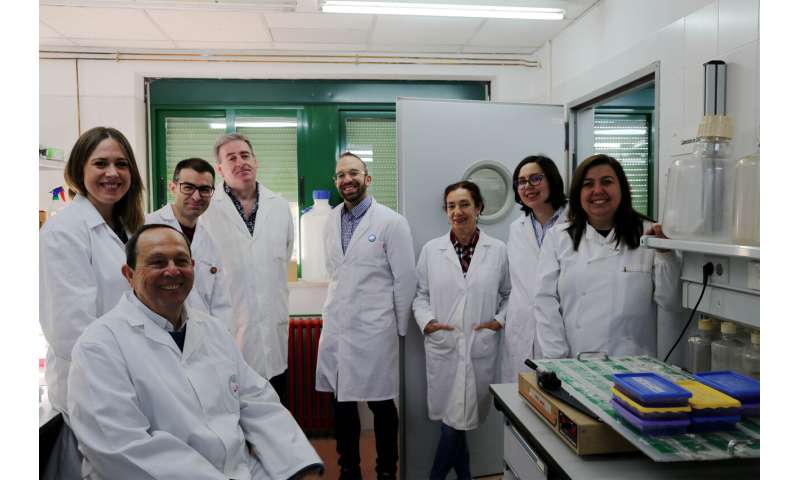Ocean changes almost starved life of oxygen

Chemical changes in the oceans more than 800 million years ago almost destroyed the oxygen-rich atmosphere that paved the way for complex life on Earth, new research suggests.
Then, as now, the planet had an "oxidizing" atmosphere, driven by phytoplankton—the "plants" of the ocean—releasing oxygen during photosynthesis.
Then, as now, the planet had an "oxidizing" atmosphere, driven by phytoplankton—the "plants" of the ocean—releasing oxygen during photosynthesis.
However, new research from an international team including the University of Exeter and spanning Toulouse, Leeds, London and Nanjing, suggests ocean changes in the early Neoproterozoic era (from one billion to 800 million years ago) may have locked away phosphorus—a vital nutrient for life—limiting phytoplankton growth and oxygen release.
The study suggests the amount of phosphorus available remained "just sufficient" to support the oxidising atmosphere—preventing a return to the "reducing" (oxygen-poor) atmosphere that existed over a billion years earlier.
"Ocean chemistry in this period changed to become 'ferruginous' (rich in iron)," said Dr. Romain Guilbaud, of CNRS (Toulouse).
"We know ocean chemistry affects the cycle of phosphorus, but the impact on phosphorus availability at this time hadn't been investigated until now.
"By analysing ocean sediments, we found that iron minerals were very effective at removing phosphorus from the water."
Phytoplankton growth also boosts atmospheric oxygen because, having split carbon and oxygen and released the oxygen, plants die and their carbon is buried—so it cannot recombine with oxygen to form carbon dioxide.
Despite reductions in photosynthesis and this organic burial of carbon, both due to limited phosphorus, the study suggests oxygen in the atmosphere dropped no lower than 1% of current levels—"just enough" to maintain an oxidizing atmosphere.
"Our observations suggest significant potential variability in atmospheric oxygen concentrations across Earth's 'middle age'," said Professor Tim Lenton, Director of the Global Systems Institute at the University of Exeter.
He added: "One question about the emergence of complex life is why it didn't happen sooner.
"Lack of oxygen and lack of nutrients are two possible reasons, and our study suggests both of these may have been the case in the early Neoproterozoic era.
"In fact, if phosphorus levels in the water had dropped any lower, it could have tipped the world back into a 'reducing' atmosphere suitable for bacteria but not for complex life."
A return to a "reducing" atmosphere would have reversed the Great Oxidation Event, which occurred about 2.5 billion years ago, during which photosynthesis by cyanobacteria in the oceans introduced free oxygen to the atmosphere.
More information: Feifei Zhang et al. Extensive marine anoxia associated with the Late Devonian Hangenberg Crisis. March 2020 Earth and Planetary Science Letters 533:115976. DOI: 10.1016/j.epsl.2019.115976
Marine cyanobacteria do not survive solely on photosynthesis
by University of Córdoba MARCH 2, 2020

The researcher team that carried out the study Credit: University of Córdoba
Marine cyanobacteria are single-cell organisms that settled in the oceans millions of years ago. They are organisms that, by means of photosynthesis, create organic material by using inorganic substances. Specifically, the cyanobacteria known as Prochlorococcus and Synechococcus are the most abundant photosynthetic organisms on Earth and they generate a large part of the oxygen necessary for life, hence the oceans are the Earth's real lungs.
Despite the relevance of marine cyanobacteria in the origin and sustainment of life, they continue to be a neverending source of information. In fact, we knew nothing about Prochlorococcus until Professor Sallie W. Chisholm, at the Massachusetts Institute of Technology, discovered it in the 1980's. At the time, it was thought that these life-creating organisms got their nourishment solely from photosynthesis (like autotrophic organisms). However, research has shown that they also feed on organic compounds from their environment.
This hypothesis is corroborated by a recently published review article in The ISME Journal, a Nature group journal, led by researchers María del Carmen Muñoz and Guadalupe Gómez, from the Department of Biochemistry and Molecular Biology at the University of Cordoba, who, along with researchers from the Adaptations in the metabolism of nitrogen and carbon in Prochlorococcus group, Antonio López, José Ángel Moreno, Jesús Díez and José Manuel García, analyzed different studies dating back to the beginning of this century. These studies produced evidence that these organisms not only get nourishment from photosynthesis, but also are able to "eat" what they need from their environment.
This research group studied the mechanism of glucose transport in marine cyanobacteria, demonstrating that when they find compounds of this kind that they find appealing, such as glucose, amino acids and compounds containing iron, sulphur and phosphorus, these organisms consume them and become more competitive.
The study of vesicles (small compartments that store compounds) that spread marine cyanobacteria also supports this finding: vesicles contain organic compounds that can feed other bacteria, which provides evidence of how important the use of organic compounds is among these organisms.
This concept change is crucial at an environmental level since it helps to better understand cycles of elements such as carbon, iron, phosphorus and nitrogen. The essential role that cyanobacteria play when producing necessary oxygen for life and sequestering excess carbon dioxide from the atmosphere is strengthened by this review of its nourishment: if cyanobacteria have an advantage by using glucose and other organic compounds taken from their environment, life on Earth also benefits from these advantages.
Explore furtherOcean changes almost starved life of oxygen
More information: M. C. Muñoz-Marín et al, Mixotrophy in marine picocyanobacteria: use of organic compounds by Prochlorococcus and Synechococcus, The ISME Journal (2020). DOI: 10.1038/s41396-020-0603-9
Journal information: ISME Journal
Provided by University of Córdoba
Marine cyanobacteria are single-cell organisms that settled in the oceans millions of years ago. They are organisms that, by means of photosynthesis, create organic material by using inorganic substances. Specifically, the cyanobacteria known as Prochlorococcus and Synechococcus are the most abundant photosynthetic organisms on Earth and they generate a large part of the oxygen necessary for life, hence the oceans are the Earth's real lungs.
Despite the relevance of marine cyanobacteria in the origin and sustainment of life, they continue to be a neverending source of information. In fact, we knew nothing about Prochlorococcus until Professor Sallie W. Chisholm, at the Massachusetts Institute of Technology, discovered it in the 1980's. At the time, it was thought that these life-creating organisms got their nourishment solely from photosynthesis (like autotrophic organisms). However, research has shown that they also feed on organic compounds from their environment.
This hypothesis is corroborated by a recently published review article in The ISME Journal, a Nature group journal, led by researchers María del Carmen Muñoz and Guadalupe Gómez, from the Department of Biochemistry and Molecular Biology at the University of Cordoba, who, along with researchers from the Adaptations in the metabolism of nitrogen and carbon in Prochlorococcus group, Antonio López, José Ángel Moreno, Jesús Díez and José Manuel García, analyzed different studies dating back to the beginning of this century. These studies produced evidence that these organisms not only get nourishment from photosynthesis, but also are able to "eat" what they need from their environment.
This research group studied the mechanism of glucose transport in marine cyanobacteria, demonstrating that when they find compounds of this kind that they find appealing, such as glucose, amino acids and compounds containing iron, sulphur and phosphorus, these organisms consume them and become more competitive.
The study of vesicles (small compartments that store compounds) that spread marine cyanobacteria also supports this finding: vesicles contain organic compounds that can feed other bacteria, which provides evidence of how important the use of organic compounds is among these organisms.
This concept change is crucial at an environmental level since it helps to better understand cycles of elements such as carbon, iron, phosphorus and nitrogen. The essential role that cyanobacteria play when producing necessary oxygen for life and sequestering excess carbon dioxide from the atmosphere is strengthened by this review of its nourishment: if cyanobacteria have an advantage by using glucose and other organic compounds taken from their environment, life on Earth also benefits from these advantages.
Explore furtherOcean changes almost starved life of oxygen
More information: M. C. Muñoz-Marín et al, Mixotrophy in marine picocyanobacteria: use of organic compounds by Prochlorococcus and Synechococcus, The ISME Journal (2020). DOI: 10.1038/s41396-020-0603-9
Journal information: ISME Journal
Provided by University of Córdoba
No comments:
Post a Comment